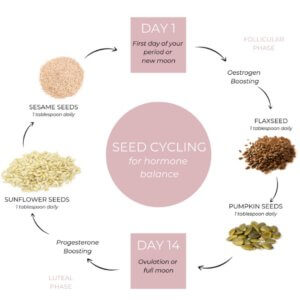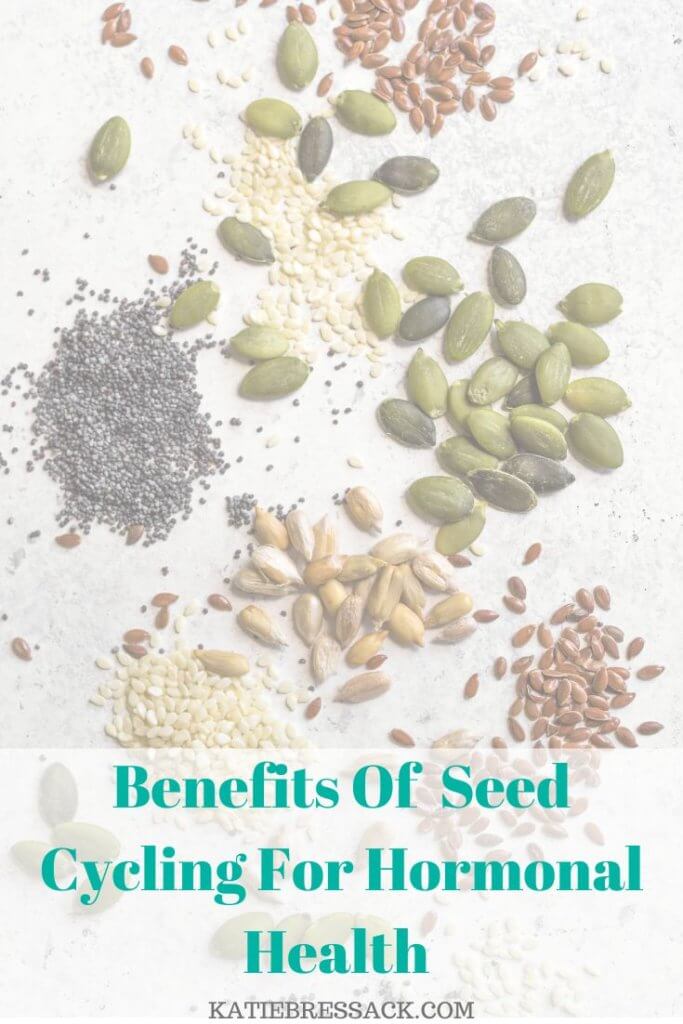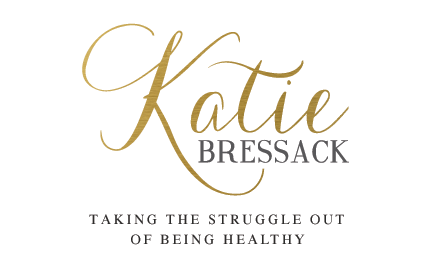The combination of eating different seeds during the follicular and luteal phase of a women’s cycle, otherwise known as “seed cycling”, has been a ritual of mine for several years. Studies show that seed cycling can help support women’s hormonal health, especially women with PCOS (Polycystic Ovarian Syndrome.) I found that seed cycling is one of the easiest things to incorporate when eating for your hormones, and today I’m sharing the benefits of seed cycling for hormonal health.
What Is Seed Cycling
Seed cycling is the practice of consuming different organic seeds within the different phases of your cycle, specifically the two main phases of follicular and luteal. The follicular phase starts on the first day of your period until you ovulate, and the luteal phase starts the day you ovulate until menstruation.
During the first phase, the follicular phase, add 1 tbsp of ground flaxseed and 1 tbsp of ground pumpkin seeds. Once you ovulate and start the luteal phase, it’s time to switch out your seeds for 1 tbsp of organic ground sesame seeds and 1 tbsp of organic ground sunflower seeds.
The key is quality. Always go for organic and ground seeds. They are much easier to digest which results in your body absorbing more nutrients.
How Do We Seed Cycle?
The reason seed cycling supports the different phases of your cycle is because of the unique nutrients in the seeds that help with our hormones.

First PHASE OF OUR CYCLE
During the first phase, follicular, we include flax seeds and pumpkin seeds because of their estrogen boosting properties.
- Flaxseeds are rich in alpha linolenic acid (ALA), omega 3-fat and fiber, and are considered a phytoestrogen which help to reduce symptoms of estrogen dominance. Now that I’m 44, this is even more important to me as I begin the next stage of hormonal health – perimenopause which starts in our late 30’s even if we are not experiencing symptoms yet.
- The other seeds we incorporate in the first phase of your cycle are pumpkin seeds. Pumpkin seeds have copper, iron, manganese, magnesium, phosphorus and zinc. Zinc helps ovarian follicles mature each month which is great for fertility. Another benefit of zinc is that it’s anti-inflammatory which is really helpful during the first phase of our cycle.
Second Phase Of Our Cycle
- During the second phase of our cycle, luteal, it’s all about the progesterone boosting foods and that’s why we also include both sesame and sunflower seeds.
- Sesame seeds are high in magnesium, calcium, zinc and lignans. Sunflower seeds are packed with vitamin E and may impact progesterone levels in this phase. They have also been linked to a reduction in pelvic and period pain.
What To Do If You Don’t Have A Regular Cycle
If you don’t have a period, seed cycling could actually help improve the chances of returning to a regular cycle. One way to establish a ritual for seed cycling is to base it on the phases of the moon until you establish your new cycle.
Here is the best way to seed cycle based on the phases of the moon:
- Days 1-14 (new moon to full moon), eat pumpkin and flaxseeds
- Days 15-28 (full moon to new moon), eat sunflower and sesame seeds
If you aren’t sure what phase of the moon we are in, you can google it or use this moon tracker so that you can seed cycle based on the phases of the moon.
Benefits Of Seed Cycling
Why does seed cycling work to help regulate your period? Because eating for your hormones is one of the best places to start when looking to support your hormonal health. When we are eating enough proteins, fats, fibers aka foods rich in nutrients this helps keep our body supported throughout the daily and monthly hormonal changes.
The seeds we are using to help support your cycle are packed with important nutrients like omega 3 fatty acids, magnesium, phytoestrogens, Vitamin B6, Vitamin E, selenium, calcium and magnesium which all play an important role in keeping our bodies supported.

Within my own practice of twelve years I’ve noticed that when my clients incorporate seed cycling consistently for at least three cycles my clients notice a more regular cycle, less mood swings, a reduction in breast tenderness, less cravings and breakouts.
Seed cycling is an incredible way to understand your cycle better. Once you start tracking your cycle and eating for your hormones you start to notice when you are ovulating, what symptoms you have each month and how that changes over time for the better. No PMS!
When I work with my clients either one-on-one or in my group programs we always start with the foundation first, eating to support blood sugar balance and eating enough protein, healthy fats and fiber at every meal and snack.
Next Steps
Registered Dietitian Kate Morton is the owner of Funk It Wellness, where I purchase my seeds for seed cycling as well as the company I recommend to my clients.
What I love about this company is that they grind the seeds and put them in two separate packages, one for each phase of your cycle so that all you need to do is measure it out and add the seeds on top of overnight oats, in smoothies, salads, power bowls or anything else where seeds can be included into your meals. If you’d like to try their seed cycling kits you can use code KatieB15 to get 15% off of your first order.
Incorporating seed cycling is a great next step to take when you are eating for your hormones. Ideally you want to seed cycle for at least three months in order to feel the benefits. Also, you don’t have to start on any specific day of your cycle so you can really start to incorporate seed cycling into your daily routine anytime.
Have questions? Comment below or reach out to me at katie@katiebressack.com. Looking for ways to improve your period, moods, energy, sleep and overall health? Be sure to sign up for a free 30 minute consultation call to see what next steps might be best to support you.
Sources:
I’d love to hear your thoughts!
- Was this post helpful for you? Or, do you have any additional questions? Comment below and let me know!
- Share with your friends, forward this along or post on social. You can also join me on Instagram and in my private FB group
- Want a deeper look into your hormones? Take my quiz to see what foods might be helpful to add into your diet
- Sign up for my newsletter full of women’s health tips and get your FREE guide, the five steps to take today to help balance your hormones
Medical Disclaimer
Information in this post and on this web site is provided for informational purposes only. The information is a result of practice experience and research by the author. This information is not intended as a substitute for the advice provided by your physician or other healthcare professional or any information contained on or in any product label or packaging. Do not use the information on this web site for diagnosing or treating a health problem or disease, or prescribing medication or other treatment. Information and statements regarding dietary supplements have not been evaluated by the Food and Drug Administration and are not intended to diagnose, treat, cure, or prevent any disease. Always speak with your physician or other healthcare professional before taking any medication or nutritional, herbal or homeopathic supplement, or using any treatment for a health problem.

.png)
.png)
.png)
Hi Katie, I started seed cycling last month, but I’m wondering, should I limit myself to those four seeds? For example, I love chia seeds, can I consume them freely during the month, or will that interfere with the process? And what if I happen to eat sunflower or sesame seeds during the first fourteen days (in addition to flax and pumpkin seeds), or vice versa, is that a problem? Thank you!
Hi,
You can definitely incorporate other seeds into your diet, I just recommend focusing on the two for each cycle and making sure you are getting those in every day.